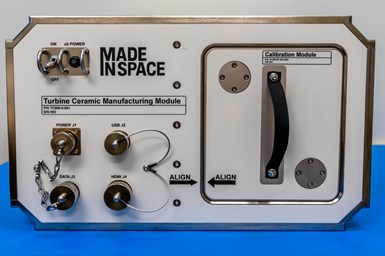Ceramic Manufacturing Module Successfully Operates in Orbit
Made In Space, a subsidiary of Redwire, demonstrates first successful ceramic additive manufacturing in space.

Ceramic Manufacturing Module
Technology from Made In Space, a subsidiary of Redwire, successfully manufactured a ceramic part in space for the first time. The company’s Ceramic Manufacturing Module (CMM) demonstrated the utility of ceramic additive manufacturing in space.
The commercially developed in-space manufacturing facility successfully operated with full autonomy using additive stereolithography (SLA) technology and pre-ceramic resins to manufacture a single-piece ceramic turbine blisk in orbit along with a series of material test coupons. According to the company, the successful manufacture of these test samples in space is an important milestone to demonstrate the proof-of-potential for CMM to produce ceramic parts that exceed the quality of turbine components made on Earth. The ceramic blisk and test coupons will be stowed and returned to Earth for analysis aboard the SpaceX Dragon CRS-21 spacecraft. The CMM is the first SLA printer to operate in orbit.
CMM aims to demonstrate that ceramic manufacturing in microgravity could enable temperature-resistant, reinforced ceramic parts with better performance, including higher strength and lower residual stress. For high-performance applications such as turbines, nuclear plants, or internal combustion engines, even small strength improvements can yield years-to-decades of superior service life.
The CMM was developed in partnership with the ISS Research Integration Office at NASA’s Johnson Space Center. The ceramic facility is one of three ISS pilot payloads developed through this partnership that aims to catalyze and scale demand for commercial capabilities in low Earth orbit by producing high-value products for terrestrial use. Made In Space first demonstrated the SLA printing technology found inside CMM through a series of parabolic flights funded through NASA’s Flight Opportunities program in 2016.
Additional technical partners for the CMM mission include HRL Laboratories of Malibu, California, and Sierra Turbines of San Jose, California. The successful CMM mission builds upon Redwire’s flight heritage with four other additive manufacturing facilities developed by the Made In Space team that have successfully flown and operated on the space station.
Related Content
-
3D Printed Titanium Replaces Aluminum for Unmanned Aircraft Wing Splice: The Cool Parts Show #72
Rapid Plasma Deposition produces the near-net-shape preform for a newly designed wing splice for remotely piloted aircraft from General Atomics. The Cool Parts Show visits Norsk Titanium, where this part is made.
-
Why AM Leads to Internal Production for Collins Aerospace (Includes Video)
A new Charlotte-area center will provide additive manufacturing expertise and production capacity for Collins business units based across the country, allowing the company to guard proprietary design and process details that are often part of AM.
-
Additive Manufacturing Is Subtractive, Too: How CNC Machining Integrates With AM (Includes Video)
For Keselowski Advanced Manufacturing, succeeding with laser powder bed fusion as a production process means developing a machine shop that is responsive to, and moves at the pacing of, metal 3D printing.













